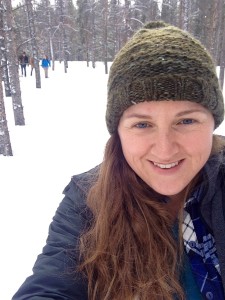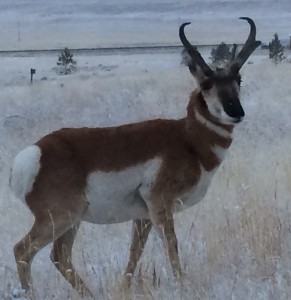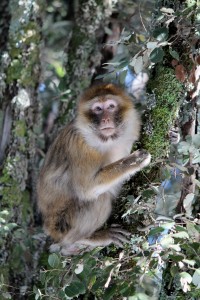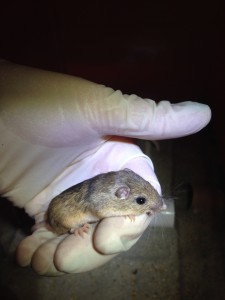Melanie LaCava
Melanie LaCava
 Melanie LaCava, PhD
Melanie LaCava, PhD
Positions: Lab Affiliate, as of June 1, 2021. 2015-2021: PhD Student with projects on Pronghorn and Mule Deer Population Genomics and Disease Ecology. As of June 1, 2021, current position is Postdoctoral Researcher, Genomic Variation Lab, UC Davis focused on conservation genomics of Delta Smelt fish.
Projects: Pronghorn population genomics, Mule deer population genomics and CWD
Education: B.Sc. in Wildlife, Fish and Conservation Biology, University of California, Davis, 2013
Certification: Certified Associate Ecologist through the Ecological Society of America (ESA)
Website: https://melanielacava.weebly.com
Research interests
I am interested in applying genetic and genomic techniques to study wildlife populations, with a foundation in conservation. I aim to utilize existing methods and explore new ideas to produce innovative research that contributes to wildlife conservation and management.

Wyoming pronghorn population genomics (UWyo doctoral research)
FWe are developing a state-wide population genomic assessment of Wyoming pronghorn to delineate genetic clusters and calculate genetic diversity indices across individuals and within genetically determined clusters. We are also investigating how natural and human-constructed landscape features affect gene flow among pronghorn in Wyoming. Working in collaboration with the WGFD Pronghorn Working Group, we are especially interested in how potential barriers such as highways affect genetic connectivity for this species.
Wyoming mule deer population genomics and CWD (UWyo doctoral research)
Chronic wasting disease (CWD) is a fatal prion disease that afflicts mule deer and other cervid species. Currently, there is no known prevention (e.g., immune response, vaccine) or treatment for CWD, however, some cervid species have polymorphisms in the prion protein gene (Prnp) that result in slower disease progression. Individuals with the “slow” Prnp genotype live longer and therefore have more opportunities to reproduce than individuals with the “fast” Prnp genotype. In collaboration with the Wyoming Game and Fish Department CWD Surveillance program, we are studying the interrelationships among genetic population connectivity, Prnp genotypes, and the spread of CWD across the landscape. We are using genome-wide single nucleotide polymorphism (SNP) data to identify genetic population units and characterize genetic connectivity in relation to natural and human-constructed landscape features.
Conservation genetics of the endangered Delta smelt (University of California, Davis)
The UC Davis Fish Conservation and Culture Lab (FCCL) maintains a refuge population of endangered Delta smelt (Hypomesus transpacificus), that is genetically managed by the UC Davis Genomic Variation Lab. Despite the conservation status of this species, little is known about key life history traits, such as reproduction, that could impact its management. For my undergraduate honors thesis, I used microsatellite genotyping and genetic parentage analysis to assess natural spawning strategies of cultured Delta smelt at the FCCL.
Comparative genetics in the family Bovidae (San Diego Zoo Institute for Conservation Research)
During a summer fellowship in the Genetics Division at the ICR, I worked on sequencing fragments of genes associated with heat response in the family Bovidae (ruminants) in order to compare desert-dwelling species with closely related species that live in temperate climates.  Our goal was to identify adaptive genetic markers that could be used in addition to existing neutral genetic markers to improve management of these species and ultimately to assess adaptive potential of species that may be newly exposed to desert conditions due to climate change.
Our goal was to identify adaptive genetic markers that could be used in addition to existing neutral genetic markers to improve management of these species and ultimately to assess adaptive potential of species that may be newly exposed to desert conditions due to climate change.

Publications
LaCava, M.E.F., R.B. Gagne, S.M. Love Stowell, K.D. Gustafson, C.A. Buerkle, L. Knox, H.B. Ernest. (2020). Pronghorn population genomics show connectivity at the core of their range. Journal of Mammalogy 101(4):1061-1071. https://doi.org/10.1093/jmammal/gyaa054
LaCava, M.E.F., E.O. Aikens, L.C. Megna, G. Randolph, C. Hubbard, C.A. Buerkle. (2020). Accuracy of de novo assembly of DNA sequences from double-digest libraries varies substantially among software. Molecular Ecology Resources 20(2):360-370. https://doi.org/10.1111/1755-0998.13108
Godwin, B.L., M.E.F. LaCava, B. Mendelsohn, R.B. Gagne, K.D. Gustafson, S.M. Love Stowell, A. Engilis, Jr., L.A. Tell, H.B. Ernest. (2020). Novel hybrid finds a peri-urban niche: Allen’s hummingbirds in souther California. Conservation Genetics 21:989-998.
https://doi.org/10.1007/s10592-020-01303-4
Mendelsohn, B., B. Bedrosian, S.M. Love Stowell, R.B. Gagne, M.E.F. LaCava, B.L. Godwin, J.M. Hull, H.B. Ernest. (2020). Population genomic diversity and structure at the discontinuous southern range of the Great Gray Owl in North America. Conservation Genetics 21:693-706.
https://doi.org/10.1007/s10592-020-01280-8
LaCava, M., K. Fisch, M. Nagel, J.C. Lindberg, B. May, A.J. Finger. (2015). Spawning behavior of cultured Delta Smelt (Hypomesus transpacificus) in a conservation hatchery. North American Journal of Aquaculture 77:255-266. https://doi.org/10.1080/15222055.2015.1007192
Long, J.Z., M. LaCava, X. Jin, B.F. Cravatt. (2011). An anatomical and temporal portrait of physiological substrates for fatty acid amide hydrolase. Journal of Lipid Research 52:337-344. http://doi.org/10.1194/jlr.M012153
Presentations
LaCava, M.E.F., S.M. Love Stowell, R.B. Gagne, K.D. Gustafson, C.A.Buerkle, L. Knox, D. McWhirter, W.H. Edwards, H.B. Ernest. (August 2020). “Genetic structure reflects habitat requirements and social structure in three Wyoming ungulates.” Oral presentation. The Ecological Society of America Annual Meeting.
LaCava, M.E.F., R.B. Gagne, S.M. Love Stowell, K.D. Gustafson, C.A. Buerkle, L. Knox, H.B. Ernest. (February 2020). “Pronghorn population genomics show connectivity at the core of their range.” Oral presentation. University of Wyoming Program in Ecology Student Symposium.
LaCava, M., S.M. Love Stowell, R.B. Gagne, and H.B. Ernest. (June 2019). “Implications of marker type and species ecology on forensic use of genetic data: STRs and SNPs in wild ungulates.” Oral presentation. Society for Wildlife Forensic Science Meeting, Denver, CO, USA.
LaCava, M., R.B. Gagne, S.M. Love Stowell, and H. B. Ernest. (August 2018). “Landscape genomic analysis of Wyoming pronghorn informs population biology and nomadic behavior.” Oral presentation. 28th Biennial Western States and Provinces Pronghorn Workshop, Reno, NV, USA.
LaCava, M., S.M. Love Stowell, M. Wood, and H. B. Ernest. (December 2017). “Landscape genomics and population health in Wyoming mule deer.” Poster presentation. The Wildlife Society Wyoming State Annual Conference, Jackson, WY, USA.
LaCava, M. (October 2017). “Landscape genomics and population health in two Wyoming ungulates.” Dissertation proposal defense.
LaCava, M., R.B. Gagne, S.M. Love Stowell, and H. B. Ernest. (November 2016). “Development of population genomic tools for Wyoming pronghorn.” Oral presentation. The Wildlife Society Wyoming State Annual Conference, Cody, WY, USA.
LaCava, M., R.B. Gagne, S.M. Love Stowell, and H. B. Ernest. (October 2016). “Development and application of population genomic tools for conservation and management of Wyoming pronghorn.” Poster presentation. The Wildlife Society’s Annual Conference, Raleigh, NC, USA.
LaCava, M., R.B. Gagne, S.M. Love Stowell, and H. B. Ernest. (August 2016). “Development and application of population genomic tools for conservation and management of Wyoming pronghorn.” Poster presentation. 27th Biennial Western States and Provinces Pronghorn Workshop, Anaconda, MT, USA.
LaCava, M. (April 2013). “Genetic analysis of Delta smelt spawning behavior” Oral presentation. Undergraduate Research, Scholarship and Creative Activities Conference, Davis, CA.
LaCava, M., J. Halbert, and A. Kelley. (March 2013). “The influence of mammalian predation on potential avian nesting habitat in wetlands of Cache Creek Nature Preserve” Poster presentation. Habitat Restoration Ecology Undergraduate Project, Davis, CA.
LaCava, M. (September 2012). “Genetic variation of genes associated with heat response in desert-dwelling mammals,” Oral presentation. San Diego Zoo Institute for Conservation Research Summer Fellowship Symposium, San Diego, CA.
Educational resources:
- Mark-Recapture Activity: This hands-on activity has the students simulate estimating wildlife population sizes using a method called mark-recapture. This activity is best-suited to high school students.
- Pronghorn adaptations: This conceptual activity asks students to think about the advantages and disadvantages of some of the physical, behavioral and physiological adaptations that pronghorn have evolved. This activity is best-suited to middle school or high school students.

